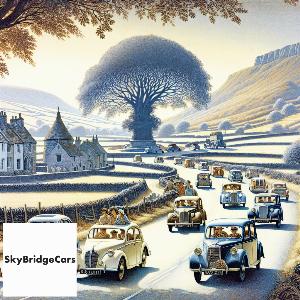Exploring Britains Traditional Brickmaking Kilns and Clay Pits by Minicab

History of Brickmaking in Britain
Brickmaking has a rich history in Britain, dating back to the Roman era. The Romans introduced the art of brickmaking, using clay and kilns to create durable building materials. The industry flourished during the Middle Ages, with the establishment of numerous brickworks across the country. The Industrial Revolution brought significant advancements, including the invention of the steam-powered brick press, which increased production rates exponentially. Today, remnants of this illustrious past can be explored through Britain's traditional brickmaking kilns and clay pits. These historical sites offer a fascinating glimpse into the country's industrial heritage. Visitors can take a transfer tour to various locations, including the famous Bursledon Brickworks in Hampshire, the last remaining steam-driven brickworks in the country. These tours provide an opportunity to learn about the traditional methods of brickmaking, from the extraction of clay to the firing process in the kilns. They also highlight the importance of this industry in shaping Britain's architectural landscape. So, hop in a transfer and embark on a journey through Britain's brickmaking history.
Traditional Brickmaking Kilns
Exploring Britain's traditional brickmaking kilns and clay pits by transfer offers a unique journey into the country's industrial past. These historical sites, scattered across the landscape, tell a story of craftsmanship and industry that shaped Britain's architectural heritage. Traditional brickmaking kilns, with their distinctive conical shape, are a testament to the skill and ingenuity of past generations. They were once the heart of a thriving industry, turning clay extracted from nearby pits into durable bricks. Today, many of these kilns and clay pits have been preserved, offering a fascinating glimpse into the past. A transfer tour allows visitors to explore these sites at their own pace, taking in the rustic beauty of the kilns and the tranquil charm of the clay pits. It's a journey that not only celebrates Britain's industrial history but also highlights the enduring appeal of traditional craftsmanship. So, hop in a transfer and embark on a unique exploration of Britain's brickmaking heritage.
Clay Pits in Britain
Britain's rich industrial history is beautifully encapsulated in its traditional brickmaking kilns and clay pits. These sites, scattered across the country, offer a fascinating glimpse into the nation's past. Clay pits, in particular, were once the lifeblood of the British brickmaking industry. They provided the raw material for the bricks that built Britain's cities and towns. Today, many of these clay pits have been reclaimed by nature, creating unique landscapes that are ripe for exploration. Travelling by transfer is an excellent way to explore these historical sites. It offers the flexibility to visit multiple locations in a single day, without the hassle of public transport. From the vast clay pits of Bedfordshire to the historic brick kilns of Staffordshire, a transfer tour can take you on a journey through Britain's industrial past. Whether you're a history buff, a nature lover, or simply looking for a unique day out, exploring Britain's traditional brickmaking kilns and clay pits by transfer is an experience not to be missed.
transfer Tours to Brickmaking Sites
Discover the rich history of Britain's traditional brickmaking industry through unique transfer tours. These tours offer an immersive experience, taking you to the heart of the country's brickmaking sites, where you can explore ancient kilns and clay pits. The journey begins with a comfortable transfer ride, allowing you to soak in the scenic beauty of Britain's countryside. Upon arrival, you'll witness the remnants of the once-thriving brickmaking industry. The kilns, with their distinctive shapes and sizes, tell a story of the craftsmanship that went into producing bricks, a material integral to Britain's architectural heritage. The clay pits, where the raw material was extracted, further add to the narrative of this age-old industry. These transfer tours not only provide a glimpse into the past but also highlight the importance of preserving these historical sites. So, buckle up for an enlightening journey into Britain's brickmaking history, a unique experience that combines travel, history, and culture in one unforgettable package.
Preservation of Brickmaking Kilns
Preserving Britain's traditional brickmaking kilns and clay pits is not just about maintaining a piece of history, but also about exploring the roots of the country's industrial past. These kilns, once the backbone of Britain's construction industry, are now fascinating sites for tourists and locals alike. A transfer tour around these historical sites offers a unique insight into the traditional methods of brickmaking, a craft that shaped the architectural landscape of Britain. The kilns and clay pits, with their distinctive shapes and structures, tell a story of the hard work and ingenuity of the brickmakers. Preservation of these sites is crucial to keep this narrative alive for future generations. A transfer ride around these sites is not just a journey through scenic landscapes, but also a trip back in time, offering a glimpse into the country's rich industrial heritage. So, hop in a transfer and embark on a journey to explore Britain's traditional brickmaking kilns and clay pits.
Brickmaking Techniques
Exploring Britain's traditional brickmaking kilns and clay pits by transfer offers a unique perspective on the country's rich industrial heritage. This journey takes you through the heart of the brickmaking industry, showcasing various techniques used over centuries. From the ancient clamp kilns to the more modern Hoffman and Bull's Trench kilns, each site tells a story of innovation and resilience. The clay pits, often overlooked, are equally fascinating. They reveal the raw material that gave birth to countless buildings and structures. The extraction and preparation of clay, a process that has evolved over time, is a testament to human ingenuity. A transfer tour allows you to delve into this history at your own pace, with the added benefit of local knowledge from your driver. Whether you're a history buff, an architecture enthusiast, or simply curious, this unique exploration of Britain's brickmaking techniques is sure to leave you with a deeper appreciation of the country's built environment.
Impact of Brickmaking on Britain's Landscape
Brickmaking has significantly shaped Britain's landscape, leaving an indelible mark on its topography and cultural heritage. The traditional brickmaking kilns and clay pits scattered across the country stand as testament to this age-old industry. These historical sites, often nestled in picturesque rural settings, offer a fascinating glimpse into Britain's industrial past. The extraction of clay for brickmaking has transformed the landscape, creating unique geographical features such as clay pits and spoil heaps. The kilns, with their distinctive shapes and structures, add a unique architectural element to the scenery. Exploring these sites by transfer provides a convenient and comfortable way to delve into this aspect of Britain's history. The journey takes you through varied landscapes, from the clay-rich regions of the South East to the brickmaking heartlands of the Midlands. Each site tells a story of the people, processes, and perseverance that have shaped Britain's built environment. This exploration offers a unique perspective on how brickmaking has impacted Britain's landscape.
Famous Brickmaking Kilns and Clay Pits
Britain's rich industrial history is beautifully encapsulated in its traditional brickmaking kilns and clay pits. These historical sites offer a fascinating glimpse into the country's past, showcasing the craftsmanship and industry that built Britain. One of the most famous brickmaking kilns is the Bursledon Brickworks in Hampshire, the last remaining steam-driven brickworks in the country. A transfer tour to this site allows visitors to explore the kiln, the clay pits, and the brickmaking machinery, providing a comprehensive understanding of the brickmaking process. Another notable site is the Bulmer Brick and Tile Company in Suffolk, which has been making bricks since the Tudor times. A transfer ride to this location offers a unique opportunity to see traditional brickmaking methods in action. Exploring these sites by transfer provides a convenient and comfortable way to delve into Britain's industrial heritage. Whether you're a history enthusiast or just curious, a visit to these brickmaking kilns and clay pits is a journey worth taking.
Brickmaking Industry in Modern Britain
The brickmaking industry in modern Britain is a fascinating blend of tradition and innovation. Despite the advent of modern technology, traditional brickmaking methods are still in use, preserving the rich heritage of this age-old craft. The country is dotted with historic brickmaking kilns and clay pits, which offer a unique insight into the industry's past. These sites, often located in picturesque rural settings, are a testament to the skill and craftsmanship of generations of brickmakers. A transfer tour of these sites is an excellent way to explore this aspect of Britain's industrial heritage. You can witness the process of brickmaking, from the extraction of clay to the firing of bricks in the kiln. The experience is not only educational but also a journey back in time, offering a glimpse into the lives of the workers who shaped Britain's architectural landscape. So, hop in a transfer and embark on a journey of discovery into the heart of Britain's brickmaking industry.
Educational Tours to Brickmaking Sites
Educational tours to brickmaking sites offer a unique opportunity to explore Britain's rich history in traditional brickmaking. These tours, often conducted by transfer, take visitors to various kilns and clay pits across the country, showcasing the intricate process of brickmaking that has been a part of Britain's industrial heritage for centuries. The journey begins with a visit to the clay pits, where the raw material for brickmaking is extracted. Here, visitors can learn about the different types of clay used and the extraction process. The tour then proceeds to the brickmaking kilns, where the clay is transformed into bricks. These kilns, some of which are still operational, provide a fascinating insight into the traditional methods of brickmaking. Educational tours to brickmaking sites not only offer a unique learning experience but also a chance to appreciate the craftsmanship and hard work that goes into every brick. Whether you're a history buff, a student, or just curious, these tours provide a unique perspective on Britain's industrial past.
Our Latest Blog Posts

Minicab Journeys to Britains Ancient Sacred Wells and Springs
Blog about transfer Journeys to Britains Ancient Sacred Wells and Springs
Read More
A Minicab Trip to Britains Most Spectacular Highland Games and Gatherings
Blog about A transfer Trip to Britains Most Spectacular Highland Games and Gatherings
Read More
Exploring Britains Classic Car Museums and Vintage Auto Shows by Minicab
Blog about Exploring Britains Classic Car Museums and Vintage Auto Shows by transfer
Read More
A Minicab Trip to Britains Most Spectacular Ice Rinks and Winter Sports Venues
Blog about A transfer Trip to Britains Most Spectacular Ice Rinks and Winter Sports Venues
Read More